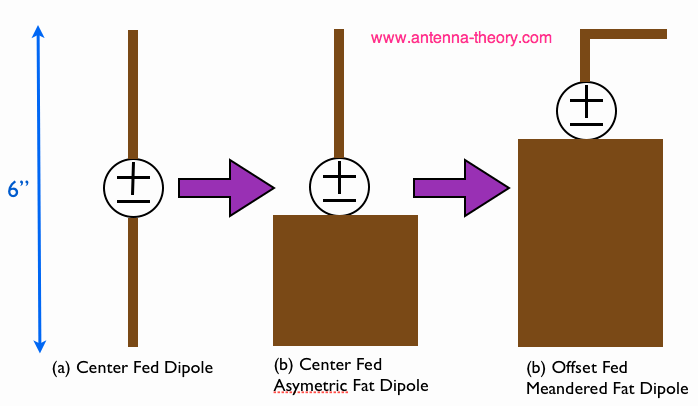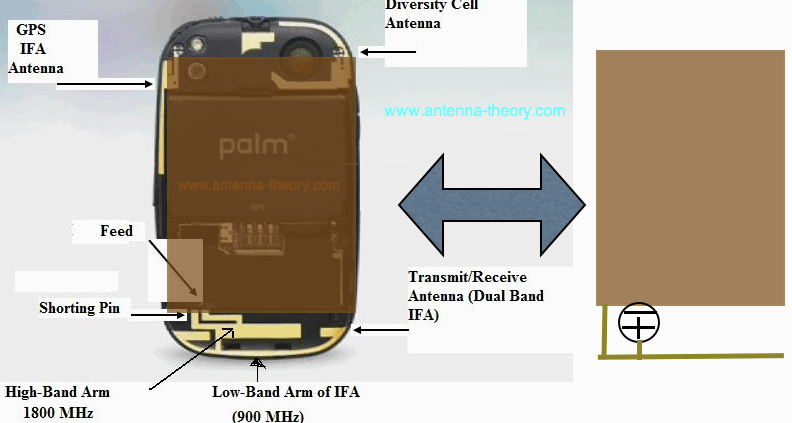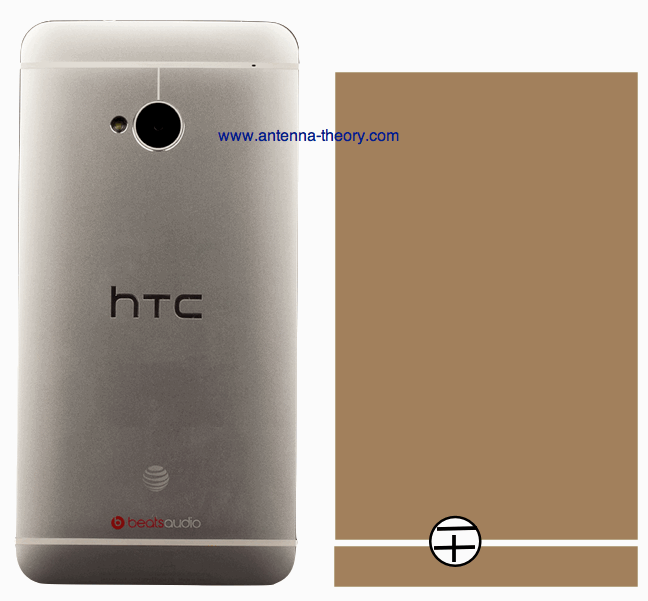Cell Phone Antenna Design
|
Smartphone antenna design (or cellular antenna design, mobile phone antenna design, etc) is reasonably complicated. There are carrier requirements (from the cell plan carriers like AT&T, Orange, China Mobile, etc), and regulatory requirements (from the FCC for instance). In addition, there are multiple antennas on each phone: Let's start by talking about these antennas. Primary Cellular Antenna DesignThe primary cellular antenna is the primary communication antenna on the smartphone, and hence is extremely important. This antenna typically is the only cellular antenna that transmits, so it has many specifications and requirements to meet. The requirements for the transmitting portion of the primary cell antenna are: The receiving requirements for the primary cell antenna are: We also need to know what frequencies the antenna will work at. The primary cellular antenna will typically have both a lowband (somewhere between 700 and 960 MHz), and a highband (somewhere between 1710 and 2700 MHz). Most phones will support some combination of the following bands/frequency ranges: The number of frequency bands expands every year. A phone that is developed for the U.S. market might only support GSM850, PCS, Band 5 (LTE and UMTS), Band 2 (LTE and UMTS). Some companies try to develop world phones that support all bands, which greatly complicates the antenna design. There are a couple things to note about the frequency bands. First, many of the bands overlap. For instance, GSM850, UMTS Band 5 and LTE Band 5 are all the same frequency range. Hence, an antenna that works well for one of these bands will largely work well for the other bands. [There are some effects the antenna designer should be aware of for different modulation types, such as GSM850 and UMTS Band 5 will have different power amplifiers (PAs), so that the SAR will be different and this will need checked to ensure no problems arise across modulations.] Secondly, note that the transmit frequencies are typically the low end of the band, with the receive frequencies at the high end of the band. For instance, for UMTS Band 5, the transmit (Tx) band is 824-849 MHz, and the receive (Rx) band is 869-894 MHz. The location of the primary cellular antenna will almost always be at the lower end of the device. The reason for this is because of the SAR requirements and because the carrier TRP specs when mounted on a mannequin head (we will call this the "head spec"). We will illustrate the "head" problem now. Suppose an antenna radiates a TRP of 20 dBm (this is 100 mW - see the decibels page). This means the TRP is 20 dBm when the phone is isolated (no loss due to the human body). If the phone is then measured when next to the human head, the TRP will decrease due to absorption by the human body. The absorption will be less if the primary cell antenna is at the bottom or lower end of the phone, because the bulk of the antenna will be farther from the head. A somewhat representative carrier requirement to sell a phone in the US may be summarized below:
Let's begin some antenna design, and we'll start with the theoretical background. Recall that a dipole antenna wants to be about a half-wavelength long so that it has a reasonable antenna efficiency and antenna bandwidth. The first thing we'll want to know is what is the lowest frequency of operation - this will have the longest wavelength - and will therefore help us determine the overall size of the antenna. Let's say our lowband is somewhere around 810 MHz. The wavelength is then c/f = 300e6/810e6 = 37 cm, so a half-wavelength is roughly 18.5 cm or 7". Now - what is the size of our handheld mobile phone? It is typically about 5-7" long. Absorb the last few sentences. What do they mean? For efficient radiation at mobile/cellular phone frequencies, the antenna must essentially be the size of the whole device. This means the antenna is not an isolated component, but will use the entire structure of the phone in order to make the antenna. The last paragraph is critical to understanding cellular antenna design for a mobile handset. We can illustrate this in Figure 1, which shows the evolution of a dipole antenna into a cellular phone antenna:  Figure 1. Evolution of Dipole Antenna to a Mobile Phone Cell Antenna. Figure 1(a) shows a simple wire dipole antenna. There is no necessity to have the antenna feed at the center of the dipole, so it can moved off of center. In addition, if the overall volume of the antenna increases, this tends to be a good thing for antenna bandwidth. Figure 1(b) shows a non-center fed dipole antenna with one fat arm. Note that the fat arm will essentially be made up of the mobile phone chassis (the groundplane of the device). In Figure 1(c), the top arm is meandered to increase the length of the dipole antenna, and from there the antenna can be evolved into an inverted-F antenna if desired. An example will show this. Check out the Palm Pre antenna, which has visible antennas in Figure 2:
 Figure 2. Palm Pre Antennas with a Simplified Diagram.
Let's talk a bit more about the cellular antenna of Figure 2 (the Palm Pre smartphone). There are two meandered arms, which are essentially both IFAs. The most difficult frequency band to cover is typically the lowband, because this is the lowest frequency and requires the most space. Hence, the antenna will first be designed for the lowband. Then a smaller arm can be added for the highband (the 1800 MHz cellular frequencies). This is why the smaller arm of the dipole/IFA antenna is added in Figure 2. The process of antenna design will start with a mockup, and then the designers will try a simple dipole or IFA, and iteratively optimize it in order to obtain the necessary frequency bands. This will require a good amount of impedance matching as well. That's a quick summary of the designing of a primary cellular antenna. Note that the antenna polarization can't really be designed, particularly for the lowband, as you are forced to use a dipole like structure as in Figure 2. This means the dominant polarization of your cellular antenna will be vertical (VP), when shown as in Figure 2. Translation of Carrier Specs into Antenna SpecsThe cell phone carriers give their specs in dBm, for instance, the TRP should be 20 dBm at Band 5. What does this mean for the antenna? The first thing that should be determined is what level of conducted power will be coming out of the radio. Conducted power is measured by cabling a 50 Ohm load to the transmitter and measuring how much power is transmitted. If the radio designers decide they can do 23 dBm of maximum output power, then a TRP of 20 dBm essentially means your antenna should have an antenna efficiency of about -3 dB at this band. Similarly, if the carrier spec for TIS is -101 dBm, then you will need to measure the conducted sensitivity of your device. If you determine that the sensitivity of your radio is -107 dBm, then this tells you that the antenna efficiency should be greater than -6 dB in order to achieve your specification. Note that for sensitivity, you'll also need to worry about desense. The SAR spec is not so straight forward. There's no quick translation from TRP to the SAR value. This requires a real SAR measurement or simulation, along with some iteration of the design to lower the SAR while maintaining antenna efficinecy.
VSWR SpecsThere's no fixed "VSWR rules" for cell phone design. Most people who don't work on antennas will tell you that the Antenna's Impedance is matched to 50 Ohms. However, given the relatively small volume of the antenna and relatively large required bandwidth, the impedance is rarely if ever exactly 50 Ohms. Typically the VSWR is less than 3, with 2 being very acceptable. The HTC OneHopefully now you understand a bit about cellular antenna design and the difficulties there. Hopefully, if you think about it, you'll understand why it is virtually impossible to have a cell phone with an entirely metal back (where would the other half of your dipole antenna go?). The 2013 HTC One has a pretty innovative antenna. The backside of the device is shown in Figure 3:
 Figure 3. The Aluminum Back HTC One - Every Non-Metallic Line is Related to An Antenna. Does the little horizontal white lines make sense looking at the back of the HTC one and knowing what we now know about antennas? The designers had to institute a thin non-metallic gap in the aluminum in order to enable the antenna to radiate. This is a very difficult design to implement because having that much metal on the back of the phone introduces a lot of parasitic capacitance (which won't radiate). Hence the designers here were treading the line between a capacitor and an antenna very tightly. To get dual band operation they would have had to get creative with impedance matching and likely used adaptive switching techniques (different switch states for different frequency bands). The good news is this works, and that makes it a great antenna design!
|
|
This page on smartphone cellular mobile phone antenna design is copyrighted. No portion can be reproduced without permission
from the webmaster. Copyright antenna-theory.com, 2012-2016, cell phone, smartphone, antenna designs.
|
|---|